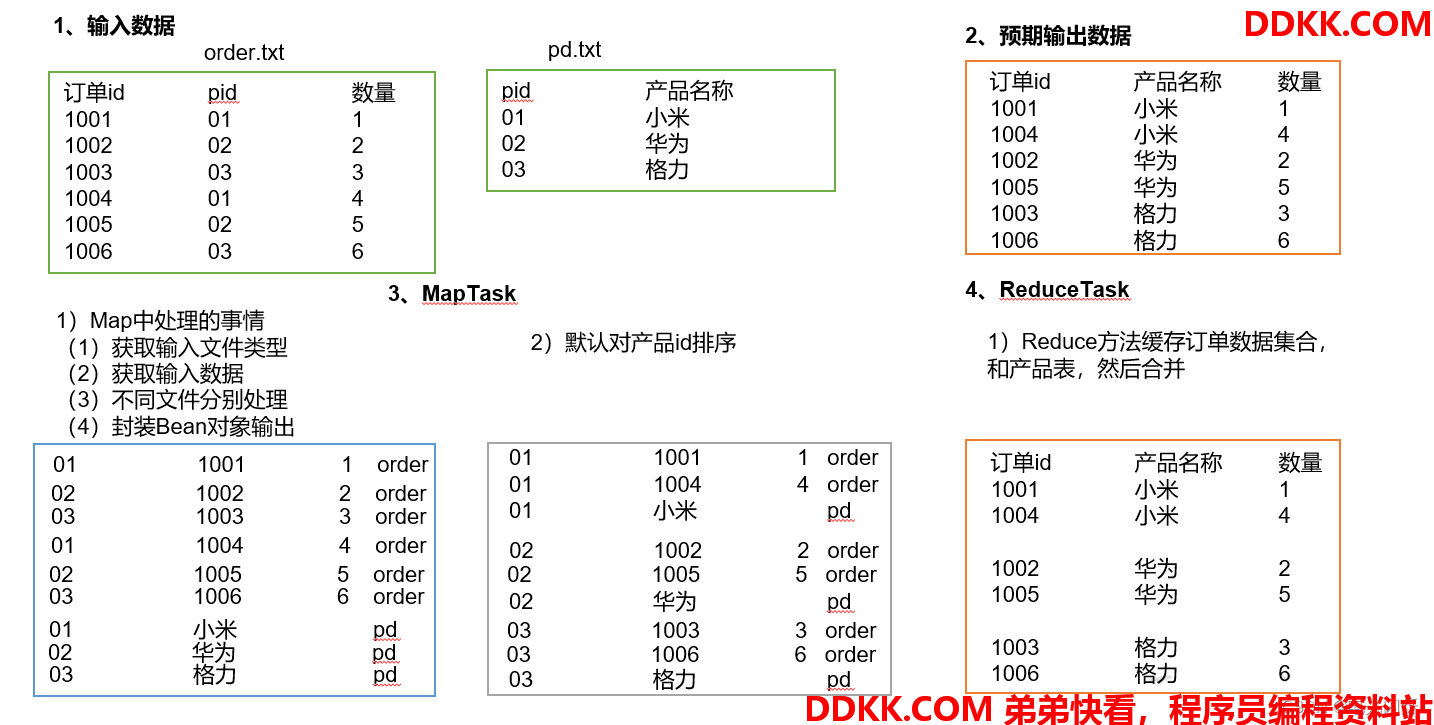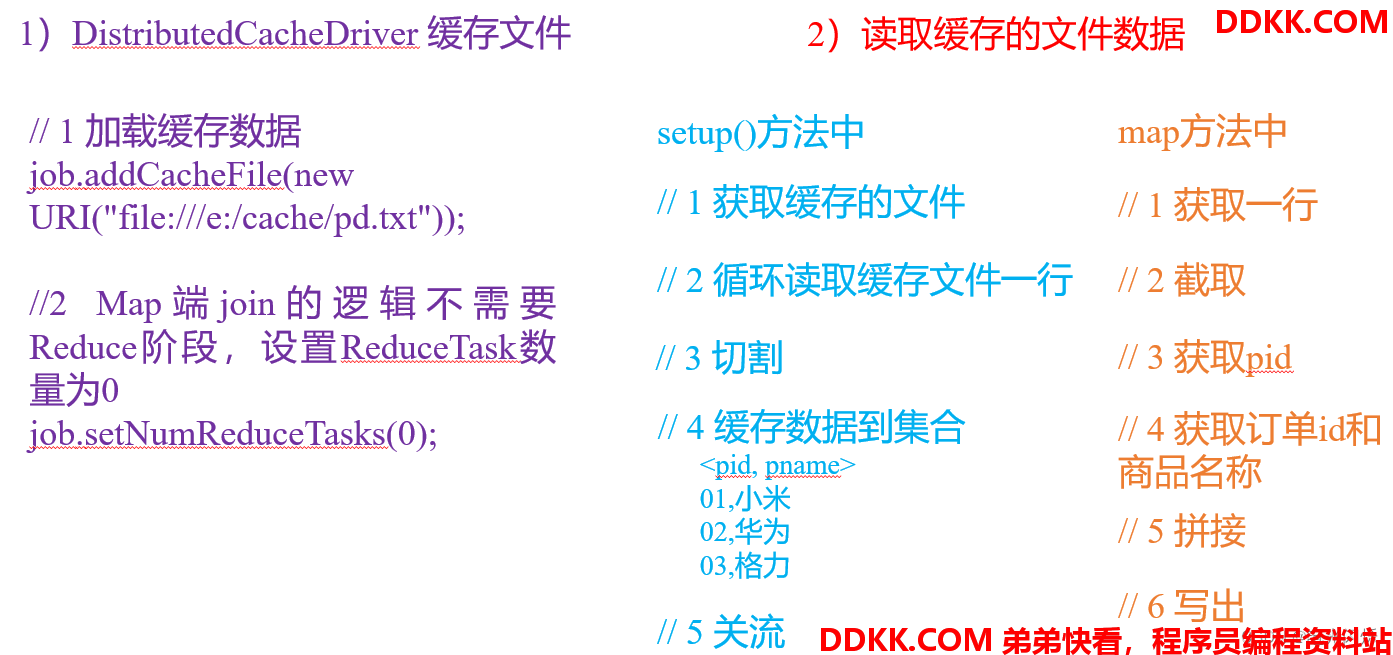1. Reduce Join
Map端的主要工作:为来自不同表或文件的key/value对,打标签以区别不同来源的记录。然后用连接字段作为key,其余部分和新加的标志作为value,最后进行输出。
Reduce端的主要工作:在Reduce端以连接字段作为key的分组已经完成,我们只需要在每一个分组当中将那些来源于不同文件的记录(在Map阶段已经打标志)分开,最后进行合并就ok了。
2. Reduce Join案例实操
2.1. 需求
将商品信息表中数据根据商品pid合并到订单数据表中。
订单数据表t_order:
1001 01 1
1002 02 2
1003 03 3
1004 01 4
1005 02 5
1006 03 6
| id | pid | amount |
| 1001 | 1 | 1 |
| 1002 | 2 | 2 |
| 1003 | 3 | 3 |
| 1004 | 1 | 4 |
| 1005 | 2 | 5 |
| 1006 | 3 | 6 |
商品信息表t_product:
01 小米
02 华为
03 格力
| pid | pname |
| 1 | 小米 |
| 2 | 华为 |
| 3 | 格力 |
最终数据形式:
| id | pname | amount |
| 1001 | 小米 | 1 |
| 1004 | 小米 | 4 |
| 1002 | 华为 | 2 |
| 1005 | 华为 | 5 |
| 1003 | 格力 | 3 |
| 1006 | 格力 | 6 |
2.2. 需求分析
通过将关联条件作为Map输出的key,将两表满足Join条件的数据并携带数据所来源的文件信息,发往同一个ReduceTask,在Reduce中进行数据的串联。
Reduce端的表合并(数据倾斜):

2.3. 代码实现
1)创建商品和订单合并后的TableBean类
import org.apache.hadoop.io.Writable;
import java.io.DataInput;
import java.io.DataOutput;
import java.io.IOException;
public class TableBean implements Writable {
private String id; //订单id
private String pid; //产品id
private int amount; //产品数量
private String pname; //产品名称
private String flag; //判断是order表还是pd表的标志字段
public TableBean() {
}
public String getId() {
return id;
}
public void setId(String id) {
this.id = id;
}
public String getPid() {
return pid;
}
public void setPid(String pid) {
this.pid = pid;
}
public int getAmount() {
return amount;
}
public void setAmount(int amount) {
this.amount = amount;
}
public String getPname() {
return pname;
}
public void setPname(String pname) {
this.pname = pname;
}
public String getFlag() {
return flag;
}
public void setFlag(String flag) {
this.flag = flag;
}
@Override
public String toString() {
return id + "\t" + pname + "\t" + amount;
}
@Override
public void write(DataOutput out) throws IOException {
out.writeUTF(id);
out.writeUTF(pid);
out.writeInt(amount);
out.writeUTF(pname);
out.writeUTF(flag);
}
@Override
public void readFields(DataInput in) throws IOException {
this.id = in.readUTF();
this.pid = in.readUTF();
this.amount = in.readInt();
this.pname = in.readUTF();
this.flag = in.readUTF();
}
}
2)编写TableMapper类
import org.apache.hadoop.io.LongWritable;
import org.apache.hadoop.io.Text;
import org.apache.hadoop.mapreduce.InputSplit;
import org.apache.hadoop.mapreduce.Mapper;
import org.apache.hadoop.mapreduce.lib.input.FileSplit;
import java.io.IOException;
public class TableMapper extends Mapper<LongWritable,Text,Text,TableBean> {
private String filename;
private Text outK = new Text();
private TableBean outV = new TableBean();
@Override
protected void setup(Context context) throws IOException, InterruptedException {
//获取对应文件名称
InputSplit split = context.getInputSplit();
FileSplit fileSplit = (FileSplit) split;
filename = fileSplit.getPath().getName();
}
@Override
protected void map(LongWritable key, Text value, Context context) throws IOException, InterruptedException {
//获取一行
String line = value.toString();
//判断是哪个文件,然后针对文件进行不同的操作
if(filename.contains("order")){ //订单表的处理
String[] split = line.split("\t");
//封装outK
outK.set(split[1]);
//封装outV
outV.setId(split[0]);
outV.setPid(split[1]);
outV.setAmount(Integer.parseInt(split[2]));
outV.setPname("");
outV.setFlag("order");
}else { //商品表的处理
String[] split = line.split("\t");
//封装outK
outK.set(split[0]);
//封装outV
outV.setId("");
outV.setPid(split[0]);
outV.setAmount(0);
outV.setPname(split[1]);
outV.setFlag("pd");
}
//写出KV
context.write(outK,outV);
}
}
3)编写TableReducer类
import org.apache.commons.beanutils.BeanUtils;
import org.apache.hadoop.io.NullWritable;
import org.apache.hadoop.io.Text;
import org.apache.hadoop.mapreduce.Reducer;
import java.io.IOException;
import java.lang.reflect.InvocationTargetException;
import java.util.ArrayList;
public class TableReducer extends Reducer<Text,TableBean,TableBean, NullWritable> {
@Override
protected void reduce(Text key, Iterable<TableBean> values, Context context) throws IOException, InterruptedException {
ArrayList<TableBean> orderBeans = new ArrayList<>();
TableBean pdBean = new TableBean();
for (TableBean value : values) {
//判断数据来自哪个表
if("order".equals(value.getFlag())){ //订单表
//创建一个临时TableBean对象接收value
TableBean tmpOrderBean = new TableBean();
try {
BeanUtils.copyProperties(tmpOrderBean,value);
} catch (IllegalAccessException e) {
e.printStackTrace();
} catch (InvocationTargetException e) {
e.printStackTrace();
}
//将临时TableBean对象添加到集合orderBeans
orderBeans.add(tmpOrderBean);
}else { //商品表
try {
BeanUtils.copyProperties(pdBean,value);
} catch (IllegalAccessException e) {
e.printStackTrace();
} catch (InvocationTargetException e) {
e.printStackTrace();
}
}
}
//遍历集合orderBeans,替换掉每个orderBean的pid为pname,然后写出
for (TableBean orderBean : orderBeans) {
orderBean.setPname(pdBean.getPname());
//写出修改后的orderBean对象
context.write(orderBean,NullWritable.get());
}
}
}
4)编写TableDriver类
import org.apache.hadoop.conf.Configuration;
import org.apache.hadoop.fs.Path;
import org.apache.hadoop.io.NullWritable;
import org.apache.hadoop.io.Text;
import org.apache.hadoop.mapreduce.Job;
import org.apache.hadoop.mapreduce.lib.input.FileInputFormat;
import org.apache.hadoop.mapreduce.lib.output.FileOutputFormat;
import java.io.IOException;
public class TableDriver {
public static void main(String[] args) throws IOException, ClassNotFoundException, InterruptedException {
Job job = Job.getInstance(new Configuration());
job.setJarByClass(TableDriver.class);
job.setMapperClass(TableMapper.class);
job.setReducerClass(TableReducer.class);
job.setMapOutputKeyClass(Text.class);
job.setMapOutputValueClass(TableBean.class);
job.setOutputKeyClass(TableBean.class);
job.setOutputValueClass(NullWritable.class);
FileInputFormat.setInputPaths(job, new Path("D:\\input"));
FileOutputFormat.setOutputPath(job, new Path("D:\\output"));
boolean b = job.waitForCompletion(true);
System.exit(b ? 0 : 1);
}
}
2.4. 测试
运行程序查看结果
1004 小米 4
1001 小米 1
1005 华为 5
1002 华为 2
1006 格力 6
1003 格力 3
2.5. 总结
缺点:这种方式中,合并的操作是在Reduce阶段完成,Reduce端的处理压力太大,Map节点的运算负载则很低,资源利用率不高,且在Reduce阶段极易产生数据倾斜。
解决方案:Map端实现数据合并。
3. Map Join
3.1. 使用场景
MapJoin适用于一张表十分小、一张表很大的场景。
3.2. 优点
思考:在Reduce端处理过多的表,非常容易产生数据倾斜。怎么办?
在Map端缓存多张表,提前处理业务逻辑,这样增加Map端业务,减少Reduce端数据的压力,尽可能的减少数据倾斜。
3.3. 具体办法:采用DistributedCache
1)在Mapper的setup阶段,将文件读取到缓存集合中。
2)在Driver驱动类中加载缓存。
//缓存普通文件到Task运行节点。
job.addCacheFile(new URI("file:///e:/cache/pd.txt"));
//如果是集群运行,需要设置HDFS路径
job.addCacheFile(new URI("hdfs://hadoop102:8020/cache/pd.txt"));
4. Map Join案例实操
4.1. 需求
将商品信息表中数据根据商品pid合并到订单数据表中。
订单数据表t_order:
1001 01 1
1002 02 2
1003 03 3
1004 01 4
1005 02 5
1006 03 6
| id | pid | amount |
| 1001 | 1 | 1 |
| 1002 | 2 | 2 |
| 1003 | 3 | 3 |
| 1004 | 1 | 4 |
| 1005 | 2 | 5 |
| 1006 | 3 | 6 |
商品信息表t_product:
01 小米
02 华为
03 格力
| pid | pname |
| 1 | 小米 |
| 2 | 华为 |
| 3 | 格力 |
最终数据形式:
| id | pname | amount |
| 1001 | 小米 | 1 |
| 1004 | 小米 | 4 |
| 1002 | 华为 | 2 |
| 1005 | 华为 | 5 |
| 1003 | 格力 | 3 |
| 1006 | 格力 | 6 |
4.2. 需求分析
MapJoin适用于关联表中有小表的情形。

4.3. 实现代码
1)先在MapJoinDriver驱动类中添加缓存文件
import org.apache.hadoop.conf.Configuration;
import org.apache.hadoop.fs.Path;
import org.apache.hadoop.io.NullWritable;
import org.apache.hadoop.io.Text;
import org.apache.hadoop.mapreduce.Job;
import org.apache.hadoop.mapreduce.lib.input.FileInputFormat;
import org.apache.hadoop.mapreduce.lib.output.FileOutputFormat;
import java.io.IOException;
import java.net.URI;
import java.net.URISyntaxException;
public class MapJoinDriver {
public static void main(String[] args) throws IOException, URISyntaxException, ClassNotFoundException, InterruptedException {
// 1 获取job信息
Configuration conf = new Configuration();
Job job = Job.getInstance(conf);
// 2 设置加载jar包路径
job.setJarByClass(MapJoinDriver.class);
// 3 关联mapper
job.setMapperClass(MapJoinMapper.class);
// 4 设置Map输出KV类型
job.setMapOutputKeyClass(Text.class);
job.setMapOutputValueClass(NullWritable.class);
// 5 设置最终输出KV类型
job.setOutputKeyClass(Text.class);
job.setOutputValueClass(NullWritable.class);
// 加载缓存数据
job.addCacheFile(new URI("file:///D:/input/tablecache/pd.txt"));
// Map端Join的逻辑不需要Reduce阶段,设置reduceTask数量为0
job.setNumReduceTasks(0);
// 6 设置输入输出路径
FileInputFormat.setInputPaths(job, new Path("D:\\input"));
FileOutputFormat.setOutputPath(job, new Path("D:\\output"));
// 7 提交
boolean b = job.waitForCompletion(true);
System.exit(b ? 0 : 1);
}
}
2)在MapJoinMapper类中的setup方法中读取缓存文件
import org.apache.commons.lang.StringUtils;
import org.apache.hadoop.fs.FSDataInputStream;
import org.apache.hadoop.fs.FileSystem;
import org.apache.hadoop.fs.Path;
import org.apache.hadoop.io.IOUtils;
import org.apache.hadoop.io.LongWritable;
import org.apache.hadoop.io.NullWritable;
import org.apache.hadoop.io.Text;
import org.apache.hadoop.mapreduce.Mapper;
import java.io.BufferedReader;
import java.io.IOException;
import java.io.InputStreamReader;
import java.net.URI;
import java.util.HashMap;
import java.util.Map;
public class MapJoinMapper extends Mapper<LongWritable, Text, Text, NullWritable> {
private Map<String, String> pdMap = new HashMap<>();
private Text text = new Text();
//任务开始前将pd数据缓存进pdMap
@Override
protected void setup(Context context) throws IOException, InterruptedException {
//通过缓存文件得到小表数据pd.txt
URI[] cacheFiles = context.getCacheFiles();
Path path = new Path(cacheFiles[0]);
//获取文件系统对象,并开流
FileSystem fs = FileSystem.get(context.getConfiguration());
FSDataInputStream fis = fs.open(path);
//通过包装流转换为reader,方便按行读取
BufferedReader reader = new BufferedReader(new InputStreamReader(fis, "UTF-8"));
//逐行读取,按行处理
String line;
while (StringUtils.isNotEmpty(line = reader.readLine())) {
//切割一行
//01 小米
String[] split = line.split("\t");
pdMap.put(split[0], split[1]);
}
//关流
IOUtils.closeStream(reader);
}
@Override
protected void map(LongWritable key, Text value, Context context) throws IOException, InterruptedException {
//读取大表数据
//1001 01 1
String[] fields = value.toString().split("\t");
//通过大表每行数据的pid,去pdMap里面取出pname
String pname = pdMap.get(fields[1]);
//将大表每行数据的pid替换为pname
text.set(fields[0] + "\t" + pname + "\t" + fields[2]);
//写出
context.write(text,NullWritable.get());
}
}